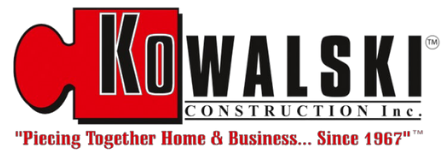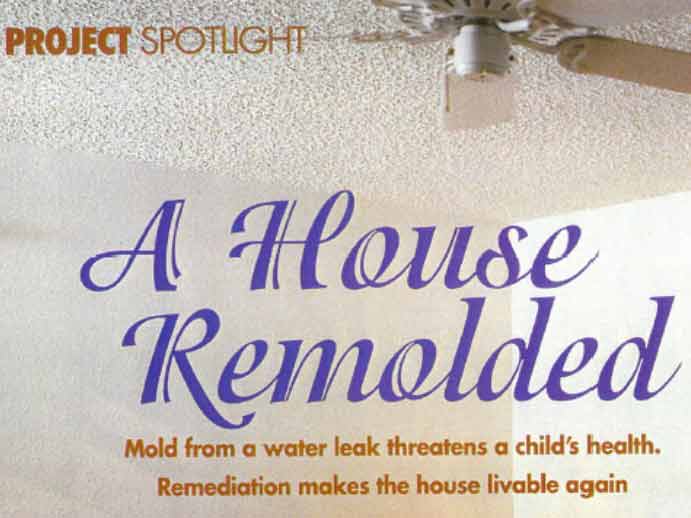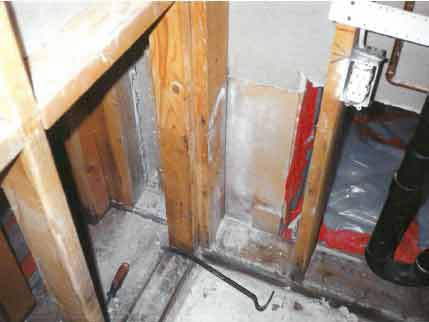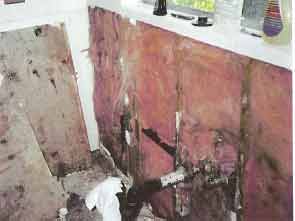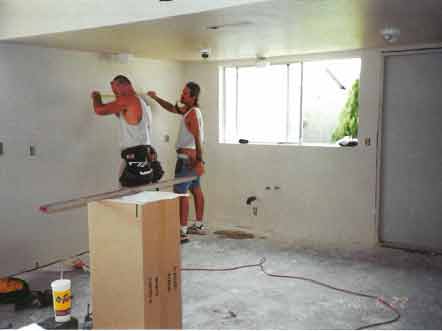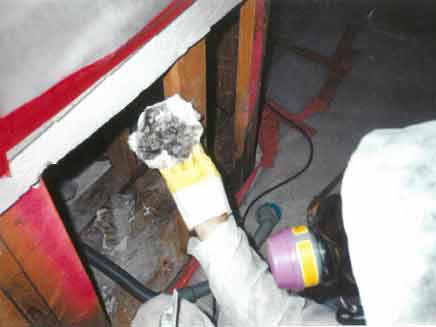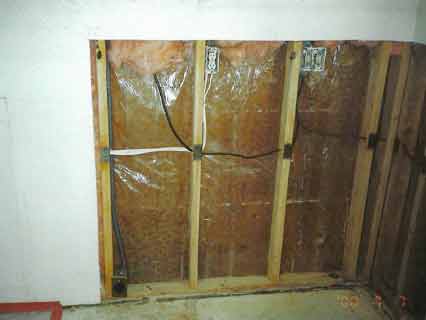A House Remodeled
The Story
Good was not enough for the Harless home repair project. This one had to be perfect. A life was at stake.
Just four months after 25-year-old Michelle Harless moved with her two sons into the Phoenix ranch house she had purchased, 7-year-old Thomas was hospitalized with breathing problems. Harless’s other son, 2-year-old James, wasn’t feeling well either, says Harless–“runny nose, lip breakout, cracked skin, loss of appetite, behavior episodes.” Harless kept catching colds and constantly felt tired.
But Thomas’s condition was life threatening because he has cystic fibrosis, a genetic disorder where glandular ducts, mainly in the lungs, liver and pancreas, become blocked. Severe episodes can be fatal.
The crisis began with a water leak involving the dishwasher. Eventually the hot water heater quit running, says Harless, and water was coming up from the bathroom tiles. Harless’s insurance carrier told her to get the leak fixed. But, having heard about the cause-and-effect relationship between water and mold, Harless suspected that her home repair problem was more complicated than a simple leak. “I’m a mother of a kid with special needs,” she says, “so I’m very cautious.
“I started calling around to get information,” she says. One company on her call list was Phoenix insurance reconstruction firm and mold-remediation specialist Kowalski Construction, a 2000 Chrysalis Award winner. “My fiancé’s mother works for the Better Business Bureau and looked up mold [remediation] specialists,” says Harless. “She saw Kowalski had a good report with the BBB and called Steve Kowalski. He sounded good to her, so I called him, too.”
Harless was impressed. “Steve was real up front with me, and kind,” she says. He advised Harless how to handle the mold problem. “I feel very comfortable with Kowalski,” Harless says. “I didn’t even want to pursue anyone else.”
At this early stage, Steve, the company’s operations manager, advised Harless not to punch a hole in the kitchen wall to access the water leak. Doing so could release mold spores trapped behind the wall allowing the mold to spread, exacerbating both the health issue and the scope of remediation needed. But Harless’s insurance company wanted that leak fixed, so the wall was pierced.
Two months after the first hospitalization, Thomas was back in the hospital for another three weeks. He had lost 30 percent of his lung function. Doctors discovered that Thomas’s problem was caused by a common mold, Aspergillus, in his lungs. Harless brought in ACT, an environmental testing company, to take samples from her house. Sure enough, the testing company found Aspergillus growing in the Harless home, revealing that Thomas’s mold-induced lung problem and the rest of the family’s health problems were no mere coincidence. Harless wanted the mold eradicated from the house — and she wanted out of the house until the work was completed. The insurance company resisted. “I was in a panic. I didn’t know what to do,” she says.
The dramatic story grabbed local newspaper headlines and television news coverage, and a personal insurance adjuster, Victor Beard, had come forward to help. He paid ACT to do its analysis and put the family in an apartment. Harless was ready to call Kowalski Construction.
“The first time we went out to the house, we met with the testing company and had a brief meeting with the insurance company,” says director of marketing Jim Kowalski. By now the insurance adjuster was convinced the mold problem was major.
For one thing, ACT had found severe and pervasive contamination. For another, the insurance company had brought in a California company to offer a second opinion, and that company quickly agreed the mold contamination was a “serious problem,” says Jim.
Without further ado, the insurance company asked Kowalski to prepare a remediation estimate. “We were the only company to give an estimate,” Jim says. Kowalski Construction based its estimate on a remediation protocol developed by ACT. “We always rely on a third party to establish what needs to be done.” Once the work has been completed, that third party also determines whether the remediation has been successful. The approach lends a more credible position to the company than being the problem analyst, the remediator, and the judge of a project’s effectiveness, he says. It also reduces the company’s liability exposure.
Kowalski’s $30,698 estimate covered cleaning and decontamination of every room and applied especially intense procedures in the kitchen and hall bathroom. Though the insurance company never questioned Kowalski’s estimate, four months passed while Harless and the insurer negotiated other job-related issues. All that time, says Kowalski, the mold contamination was worsening. In June, Kowalski received a signed contract. The next week four Kowalski employees, all trained and certified mold remediation technicians, began work.
It took two days to set up a containment room and transition zone, where workers decontaminated by shower each time they entered or exited the work area. They dressed in full decon gear — Tyvek suit, gloves, boots, full-face respirator. To keep mold spores from blowing around, the air conditioning was turned off. In Phoenix’s summer heat, the crew members were sweating before even starting work. They worked half hour stretches before needing to escape the heat.
The crew removed contaminated drywall, sanded the contaminated surface of wood framing, cleaned all contaminated areas with mold killer and disinfectant, and encapsulated affected surfaces with special anti-microbial sealer. All contaminated areas were HEPA vacuumed. Discarded materials were double-bagged for disposal.
In the kitchen, the cabinets and flooring were replaced. All appliances were removed, cleaned and re-installed. New drywall and baseboard went in. The crew removed all bathroom fixtures, replaced one tub, cleaned and disinfected every surface of the rooms, reset the fixtures and replaced the flooring. Other rooms in the house underwent floor to ceiling cleaning. Even the HVAC, kitchen and laundry ducts were thoroughly cleaned and disinfected.
Kowalski cleaned and stored almost all the house’s contents. Only Thomas’s mattress and a few pieces of living room furniture were replaced. Mold remediation is a painstaking process under any circumstances, but Kowalski wanted to be extra careful with Harless job. “We identified with her experience,” says Jim. “Her little boy was constantly on our minds and our workers minds. We checked our work once, and we checked it twice. We didn’t want to cause any further harm.” In mid-July, ACT tested the site and gave the go-ahead for final remediation procedures. ACT’s post-remediation test gave the house a clean bill of health. Close-up began shortly after.
Harless says when Kowalski Construction became involved in the mold remediation, they took care of things. “It took pressure off my mind, and I knew somehow it was going to be OK.” Once in a while, though, the pressure did escalate. A few times Harless called Kowalski with complaints. The baseboard stain color was not what she expected, for example, and some drywall texturing did, as Kowalski had pointed out earlier, need to be redone. Jim understood. “She was frustrated, having been out of her home for so long,” he says. The company redid the stain and texturing for free.
By late August, the job was winding down. Then, when Harless was scheduled to relinquish her apartment and return home, Kowalski discovered that the kitchen floor covering was not in stock and had to be ordered. That caused a crucial, three-day delay. “We had to arrange for her to live in a hotel for three days [at our expense],” says Jim. Though disappointed, Harless made the best of it. “This hotel was our vacation,” she says.
At last, Harless and her family moved back into their mold-free house Sept. 4. “I’m finally home,” she says. Making the house livable again for Harless and her boys was Kowalski Construction’s primary objective, says Jim, “We have the satisfaction of knowing that we could end the nightmare for them.”
